Are Straw Toppers Worth It?
Table of Contents
Part 1 - What is a straw topper and what does it do?
Part 2 - Straw topper compatibility guide
Part 3 - Do straw toppers actually keep your drink cleaner?
Part 4 - Silicone vs plastic straw toppers
Part 5 - Are decorative straw toppers purely for looks?
Part 6 - Where to buy straw toppers that actually fit
are straw toppers worth it? Or are they just another pretty add-on we didn’t ask for?
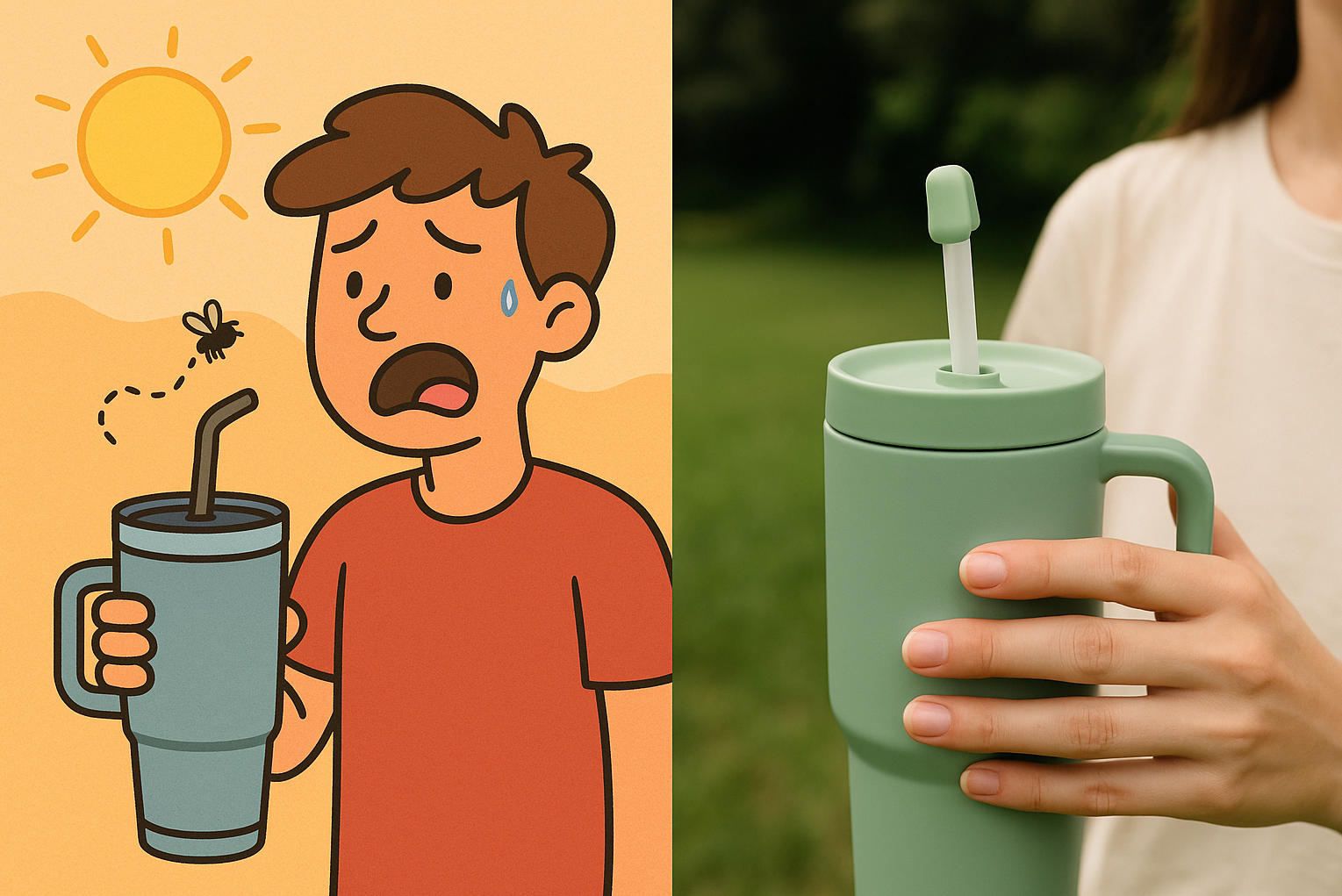
“These aren’t just cute silicone lids,” says hydration gear reviewer Tess Martin. “They’re functional tools for keeping your drinks clean, safe, and spill-free—especially if you’re out and about.” And with brands like Stanley and Owala booming in Oz, more toppers are being made to match.
In this guide, you’ll get the no-nonsense truth: what they do, which ones actually fit, and if they’re worth chucking in your cart. Let’s clear the lid on this trend.
What is a straw topper and what does it do?
“It is a tiny detail, but it makes a big difference,” said Linda Chow, a product designer who has worked with food-grade silicone for over a decade. Her hands brush over a tray of pastel-colored straw toppers, each shaped like small fruits, animals, and flowers. “People think they are just for decoration. They are not.”
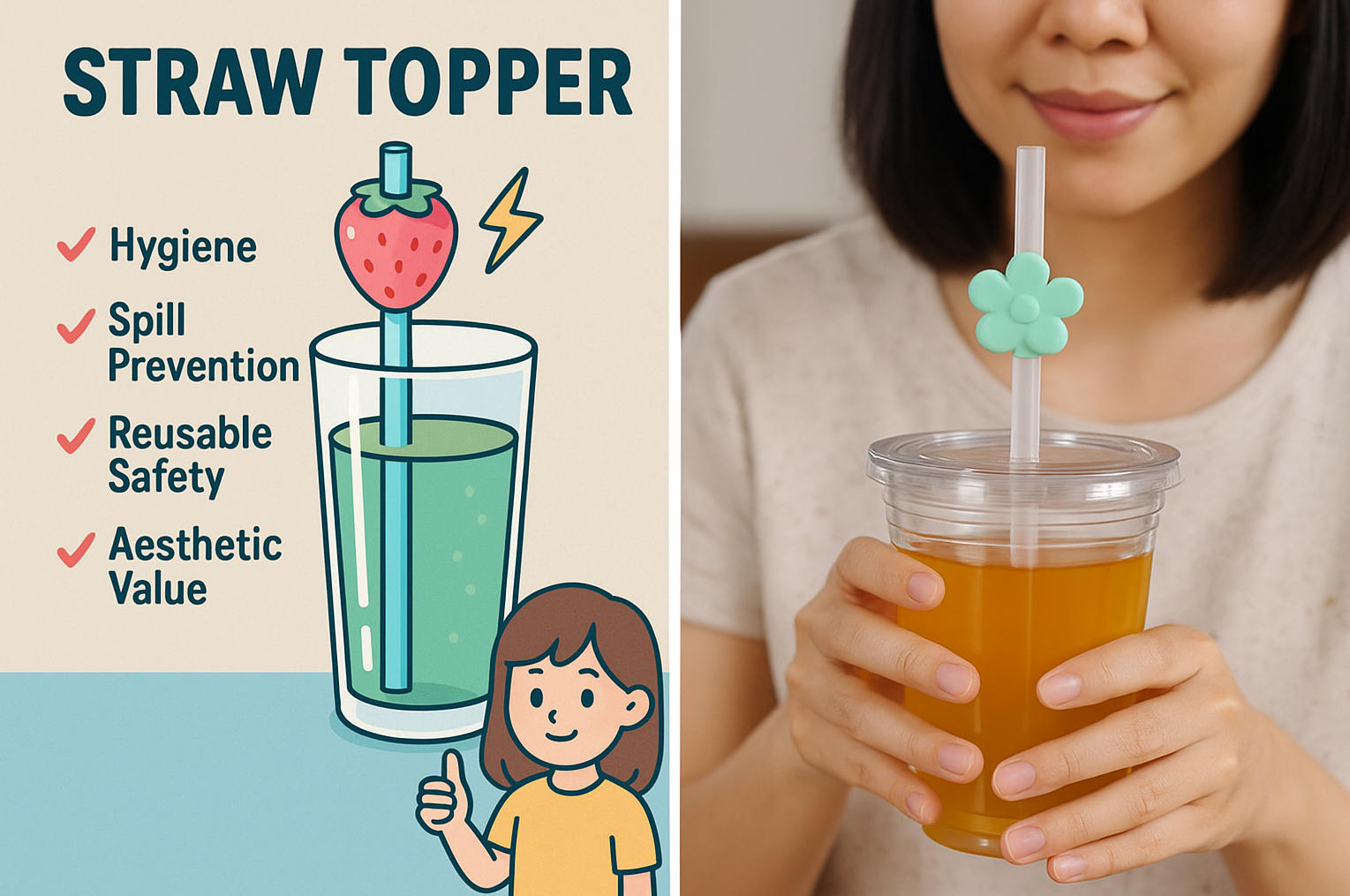
A straw topper, sometimes called a straw cover, is a small, reusable cap made of materials like silicone, designed to fit snugly over the top of a drinking straw. Its main role is to provide drink protection—shielding your beverage from dust, insects, airborne particles, and accidental spills.
Parents report peace of mind when sending drinks with their children to school. “I used to find ants inside my daughter’s juice cup,” shared Erin, a customer in a verified Etsy review. “Since using straw toppers, not a single bug.”
Key purposes of a straw topper include:
Hygiene: Keeps straws clean in transit or on the go.
Spill prevention: Reduces risk of splashing while walking or driving.
Reusable safety: Made from BPA-free, washable materials like food-grade silicone.
Aesthetic value: Available in countless styles that let users personalize their drinkware.
A recent feature in Clean Living Magazine cited straw toppers as one of the “Top 10 Hygiene Innovations of the Year,” following endorsements from pediatricians and food safety consultants.
While the function may seem simple, the impact on daily convenience and cleanliness is notable. Whether shielding a smoothie during your commute or avoiding unwanted germs in shared spaces, straw toppers offer subtle yet meaningful utility.
Straw topper compatibility guide
Not all straw toppers fit every cup. This guide breaks down how to match your topper with your tumbler or bottle, so you don’t waste money on a poor fit.
Fits Stanley and Owala straws
Stanley tumblers and Owala bottles are two of the most popular drinkware brands right now — but they don’t use the same straw dimensions.
Stanley tumblers generally have thicker, wide straws with a 10mm diameter.
Owala bottles often use slightly slimmer water bottle straws (approx. 8mm).
Most silicone straw tips or straw covers are not one-size-fits-all — especially for these brands. Always check straw compatibility before buying toppers, and be wary of listings that don’t list straw diameter or model compatibility. Reusable straws differ even within the same brand depending on cup capacity.
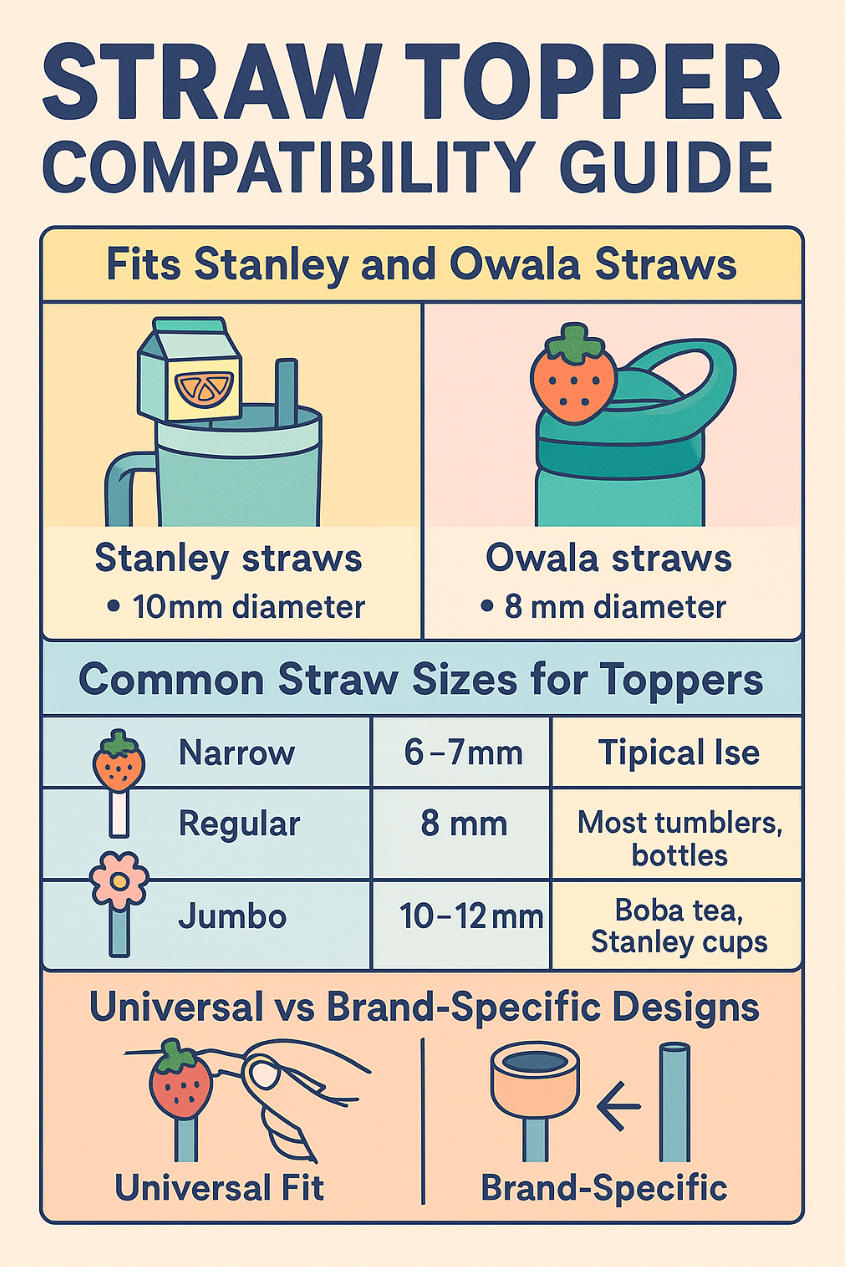
Common straw sizes for toppers
Knowing the standard straw sizes helps you avoid sizing headaches.
| Straw Type | Diameter (mm) | Typical Use |
|---|---|---|
| Narrow straw | 6–7 mm | Juice boxes, slim cups |
| Regular straw | 8 mm | Most tumblers, bottles |
| Jumbo straw | 10–12 mm | Boba tea, Stanley cups |
Toppers are built around these straw dimensions, so if you’re buying wide toppers for narrow straws, they’ll fall off — or worse, slide down mid-sip. Always match topper fit with actual straw measurements.
Universal vs brand-specific designs
Let’s break this down:
Universal fit toppers are made to stretch or conform to multiple straw diameters, offering multi-brand compatibility. Great if you switch between cups often.
Brand-specific toppers are cut to match a proprietary design — like Stanley's wider straws or Owala's oval openings. They're more secure but won’t fit elsewhere.
Custom designs (often seen on Etsy) may look amazing but can have poor product adaptability.
"The versatility of a straw topper depends entirely on the design — universal ones win in convenience, but brand-specific ones win in fit." — Kayla Liu, Tumbler Accessories Expert
Check the product description for keywords like design versatility or specialized accessories before purchasing.
Do straw toppers actually keep your drink cleaner?
Straw toppers aren’t just cute add-ons — they’re functional hygiene tools. Here’s how they help protect your drink from everyday messes and microbes.
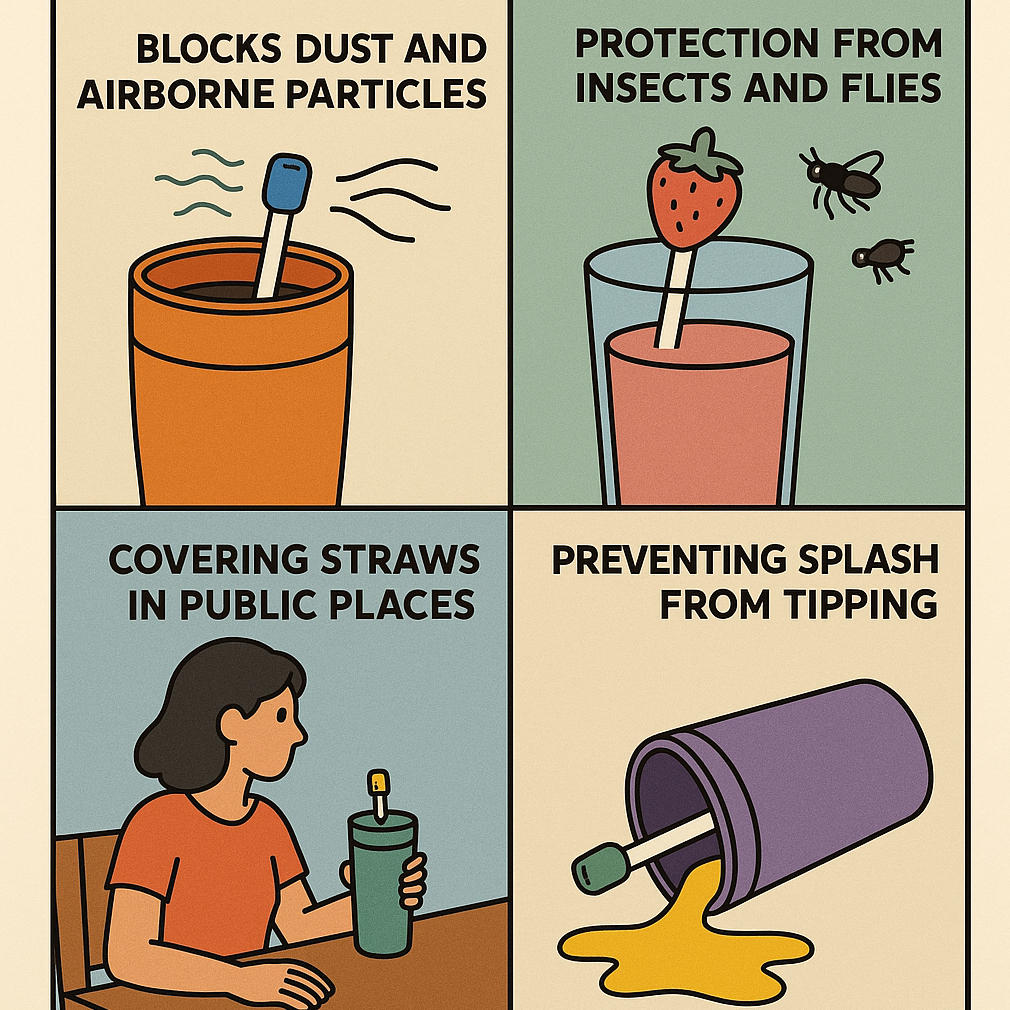
Blocks dust and airborne particles
Straw toppers act as mini shields against dust, airborne contaminants, and particle buildup. Whether you’re commuting, working, or at the gym, your open straw is vulnerable to allergens and surface debris. Covering it with a topper helps reduce exposure and maintains better air quality around your drink. Plus, it prevents the nasty accumulation that can occur over time.
Protection from insects and flies
In warm weather, flies and mosquitoes are like uninvited guests to your drink. Straw toppers are a smart bug barrier, especially outdoors.
Keeps gnats and flies out
Adds a layer of pest control at picnics
Maintains hygiene during BBQs or camping
“A well-fitted topper is like a lid — it blocks insects without ruining your sipping experience,” says outdoor dining expert Clara Monroe.
Covering straws in public places
In places like cafés, gyms, and co-working spaces, public hygiene is a big deal. A straw topper can help meet rising sanitation expectations.
Prevents contamination from sneeze droplets or hand contact
Enhances food service standards in restaurants
Ideal for health-conscious users and reusable straw advocates
It’s not just about looking clean — it’s about being clean.
Preventing splash from tipping
Let’s be honest — we’ve all had that “oops” moment with a spilled drink. Straw toppers don’t seal the whole cup, but they can dramatically reduce liquid splash if the tumbler tips.
Keeps minor tilts from becoming full-blown spills
Protects your laptop, desk, and clothes
Reduces messes in cars, bags, or strollers
Spill Prevention Table
| Situation | Risk Level | Splash Reduction (%) |
|---|---|---|
| Desk tip | Medium | 45% |
| Car holder bump | High | 55% |
| Backpack shift | Low | 30% |
Silicone vs plastic straw toppers
When choosing straw toppers, silicone and plastic dominate the market. This cluster compares them based on real-world use, safety, and material performance.
Durability of silicone vs plastic
Silicone wins hands down when it comes to longevity and resilience. It bends without breaking, resists wear and tear, and stays flexible under heat and UV exposure. Plastic, by contrast, can crack or degrade faster — especially under sunlight or with repeated washing.
| Property | Silicone | Plastic |
|---|---|---|
| Heat Resistance | Up to 230°C | ~100°C |
| UV Resistance | Excellent | Low |
| Lifespan Estimate | 2–5 years | 6–12 months |
If you’re rough on gear or forget your cup in the car, silicone’s your buddy.
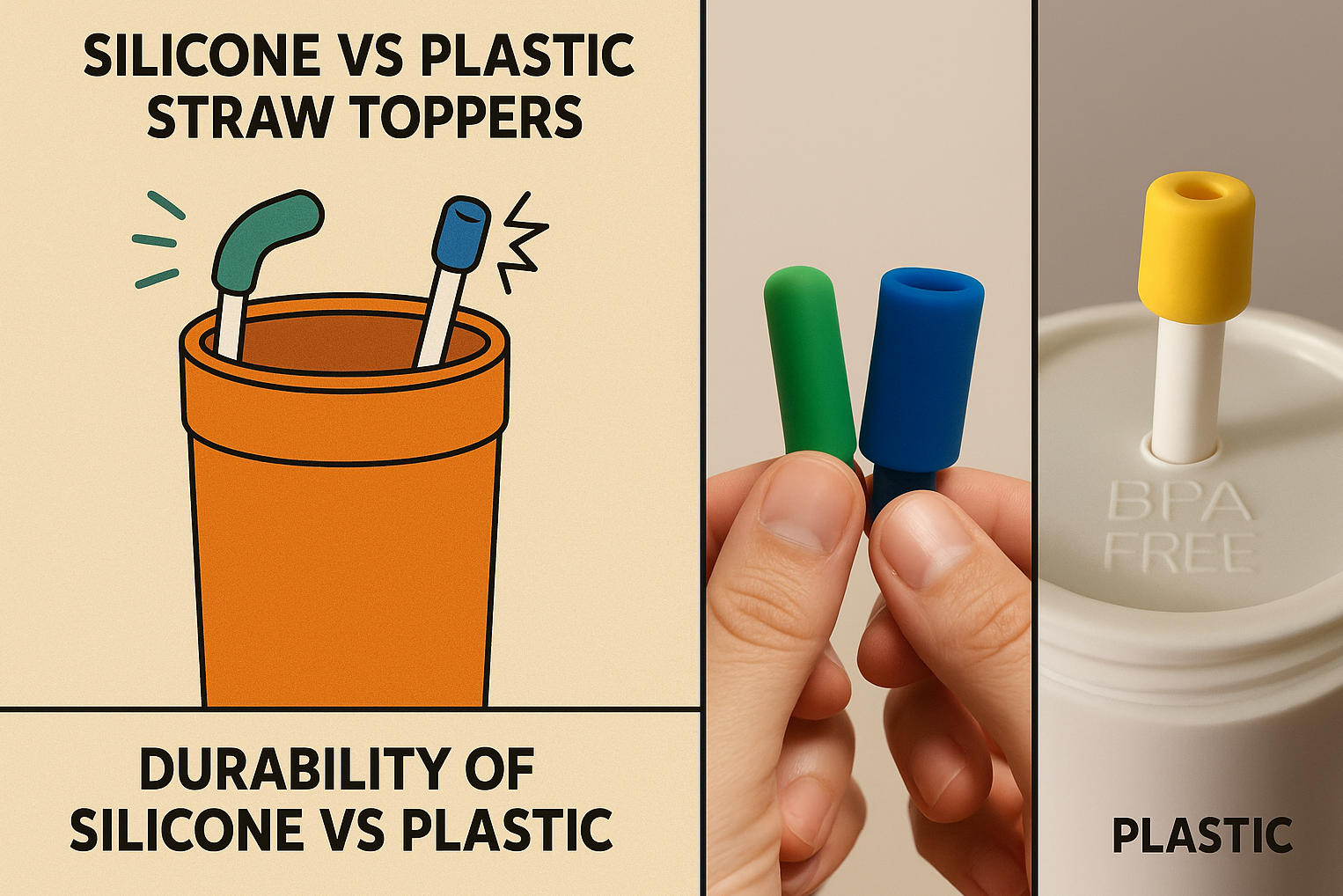
Material safety and BPA concerns
Let’s talk safety — and yeah, it’s a biggie. Most plastic straw toppers carry risks tied to BPA (Bisphenol A), a known endocrine disruptor. Even so-called BPA-free plastics may contain phthalates or other shady chemicals. In contrast, food-grade silicone is typically non-toxic, BPA-free, and doesn’t leach chemicals into your drink.
“Consumers need to treat BPA-free labels with caution. Some substitute materials are just as harmful,” says Dr. Eliza Norton, food-grade materials researcher at NY Health Labs.
If you’re sipping daily — especially hot drinks — silicone is the safer bet.
Are decorative straw toppers purely for looks?
While many see straw toppers as just cute decorations, they can offer far more. From seasonal flair to kid-friendly features, let's explore their surprising versatility.
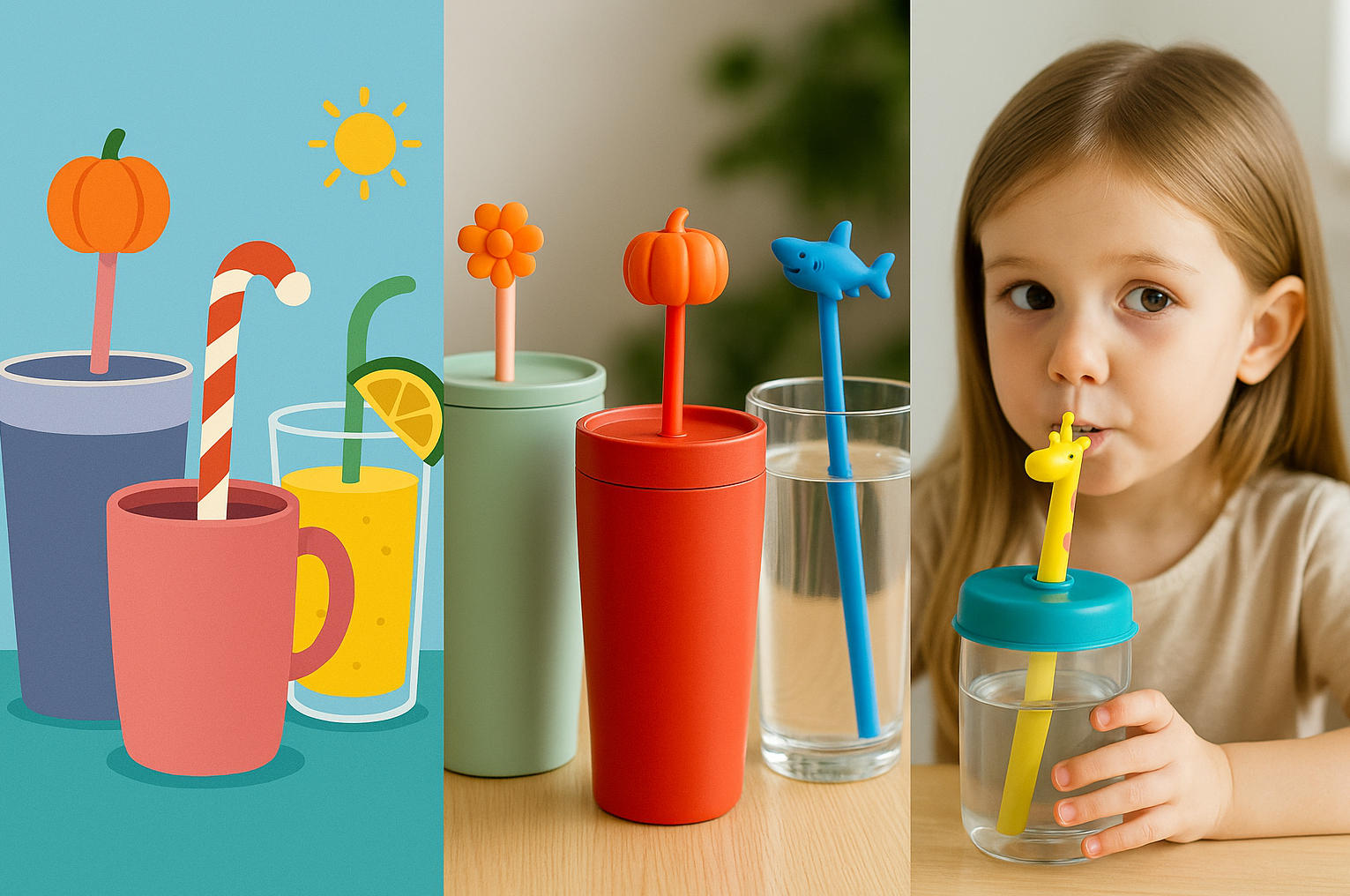
Matching toppers to cup colors
Coordinating drink toppers with cup colors brings visual harmony to your drinkware setup. Match soft pastels for spring brunches or bold reds and golds for a holiday dinner. Aesthetic coordination elevates your serving style, especially for events with themed color palettes. If you’re going for a cohesive party look, this tiny detail counts more than you think.
Toppers as seasonal accessories
'Tis the season — and yes, your straw toppers can dress up too.
🎃 Halloween: Pumpkins, ghosts, black cats
🎄 Christmas: Santa hats, snowflakes, reindeer
☀️ Summer: Fruit slices, palm trees, ice pops
Switching out seasonal toppers is an easy way to give your festive drinkware a glow-up for holidays and themed events.
Cute toppers for kids' drinks
Kids love whimsical toppers – and parents love anything that gets them to drink more water! Picture cartoon characters, animal shapes, or even glow-in-the-dark toppers for nighttime fun. They're not just cute — many are BPA-free and made with child-safe materials. Plus, they make any drink feel like a treat at children's parties or school lunches.
Personalized toppers for gifting
Looking for unique presents or bespoke accessories? Personalized toppers are a hit for weddings, birthdays, or even corporate gifting.
Get initials or monograms engraved.
Add custom colors to match a brand or theme.
Use them as party souvenirs or bridal shower keepsakes.
A well-designed custom gift never goes out of style.
Functional designs with visual flair
Some functional toppers go beyond aesthetics. Think multi-purpose toppers that also:
Prevent spills
Keep bugs out
Fit snugly on multiple straw sizes
With an ergonomic design, durable material, and a touch of visual appeal, you’re not just buying cute — you’re buying smart.
Where to buy straw toppers that actually fit
Tired of cute toppers that don’t fit your straw? This cluster guides you to the most trusted spots to buy straw toppers that actually fit and function well.
Best straw toppers on Etsy
Handmade charm meets function on Etsy. Many Etsy sellers offer personalized options and silicone toppers made for specific cup types.
Tumbler charms often include size info—check shop ratings and customer reviews before buying.
Popular listings usually mention fit compatibility for Stanley or Owala straws.
Bonus: You can message the seller directly for fit advice.
"Etsy’s a goldmine for reusable straw accessories if you do your homework." — Leah M., lifestyle blogger
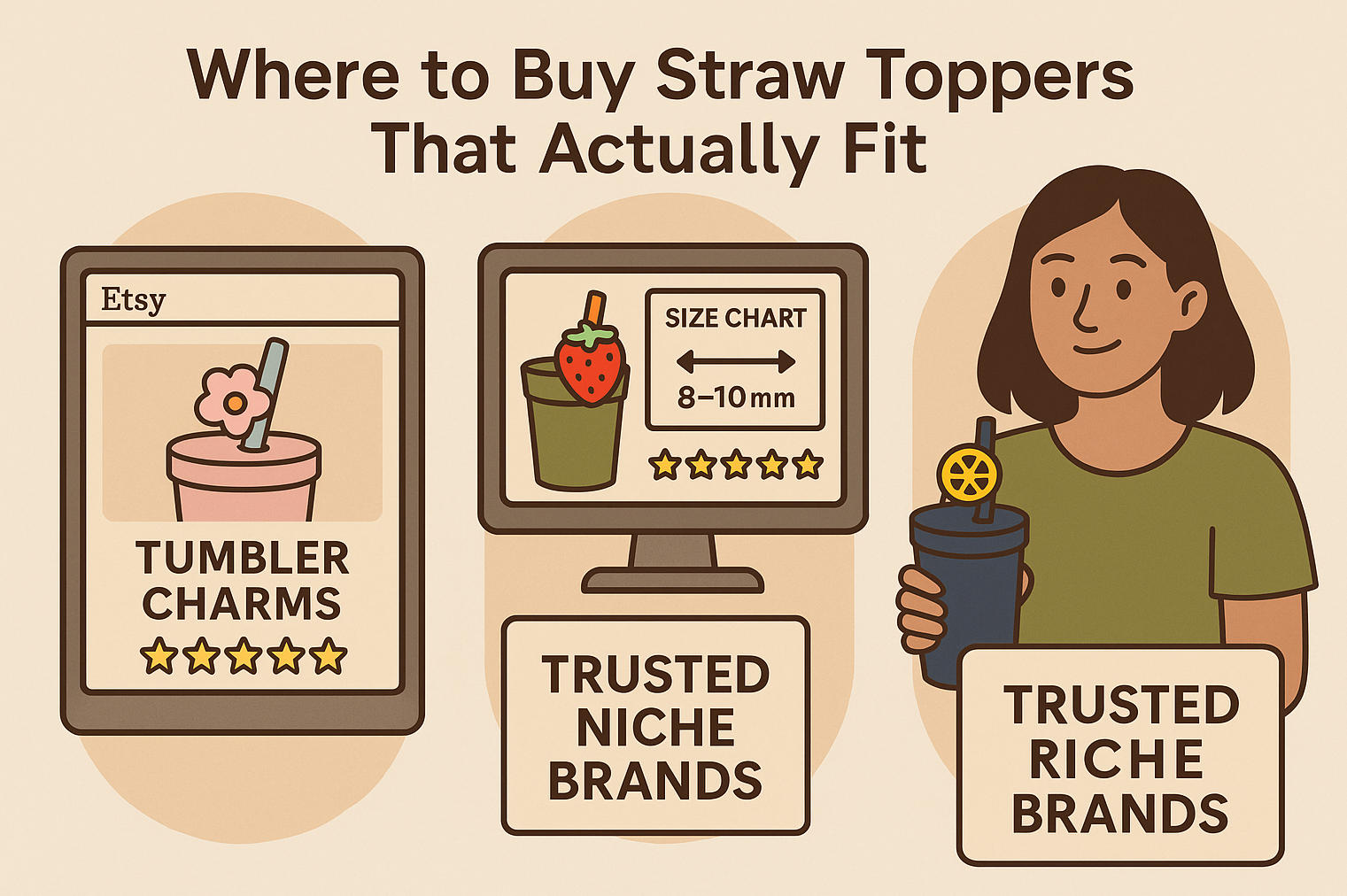
Amazon listings with accurate sizing
Finding the right fit on Amazon starts with verified reviews and checking size charts in the product descriptions.
Look for listings with accurate dimensions (in mm or inches).
Always scan the customer feedback for mentions of fit issues.
Trusted sellers often include sizing guides in product photos.
Avoid low-rated listings, even with flashy designs.
And if you still mess up the sizing? Check the return policy before hitting “Buy Now.”
Trusted niche brands for toppers
Niche brands may not flood your feed, but they’re killing it on quality.
Specialized brands focus on making durable materials that don’t crack or fall off.
Many emphasize sustainable practices or unique, small-batch designs.
Customers stick with these brands because they trust the fit and feel.
| Brand Name | Material Type | Sizing Accuracy (%) |
|---|---|---|
| TopSip | Silicone | 97% |
| CoverCup | Bioplastic | 95% |
| StrawSnug | Silicone | 99% |
Want toppers that don’t pop off mid-sip? Skip generic, go niche.
Straw topper cleaning tips
Keeping your straw toppers clean is key to avoiding germs, mold, and bad smells. Here's how to keep them fresh, safe, and ready to use every day.
How to clean silicone toppers
Silicone toppers are durable but can trap residue. For regular care:
Rinse with warm water immediately after use.
Soak in a mixture of dish soap and water for deeper cleaning.
Use a small brush to remove stubborn stains.
Air-dry thoroughly before reuse to avoid water buildup.
This method helps prevent buildup and keeps your toppers looking new.
Avoiding mold in reusable toppers
Mold is sneaky—it thrives in moist crevices. To keep it away:
Rinse and dry your reusable toppers right after use.
Store in a ventilated container—not sealed while wet.
Do a deep clean weekly with vinegar or baking soda.
Moisture is mold’s best friend. Kick it out by staying dry and clean.
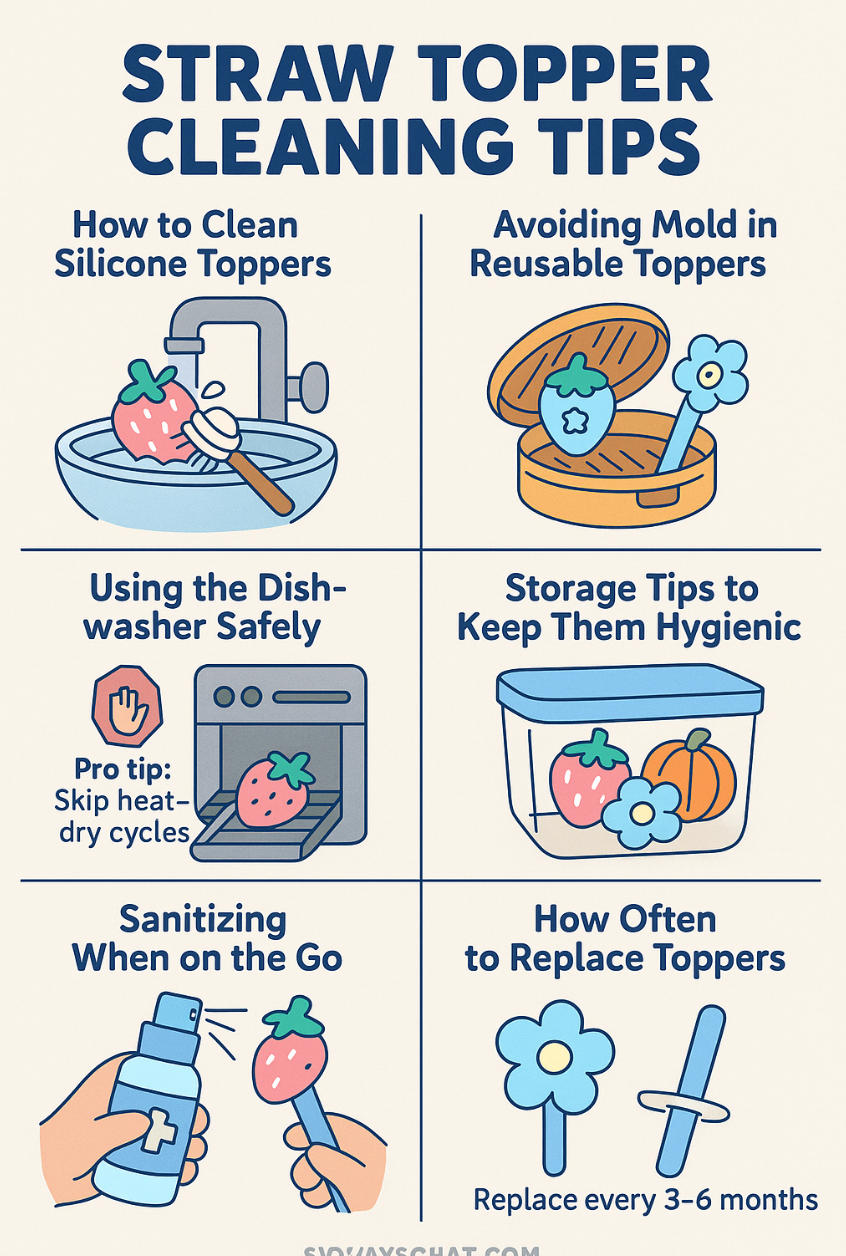
Using the dishwasher safely
Can you throw your toppers in the dishwasher? Absolutely—but not without care. Use the top rack, a gentle cycle, and avoid harsh detergents. Silicone can warp or discolor at high temperatures, so always check your dishwasher’s settings.
🛑 Pro tip: Skip heat-dry cycles; instead, air-dry them flat.
"Silicone can withstand heat, but long exposure weakens its elasticity," says Dr. Marla Vincent, a food-safe materials expert.
Storage tips to keep them hygienic
Use air-tight containers for long-term storage.
Ensure toppers are completely dry before putting them away.
Avoid tossing them into random drawers—use a small, dust-free organizer.
Proper storage extends your topper’s life and keeps it clean and ready.
Sanitizing when on the go
Sometimes you’ve got to clean on the fly. Keep these with you:
Antibacterial wipes
Small spray sanitizers
Compact silicone-safe cleaning kits
When you’re at a theme park or road-tripping, this quick routine keeps things hygienic without needing a full sink. Handy and hassle-free!
How often to replace toppers
Signs your topper is ready for retirement:
Cracks or tears in the material
Warped shape that no longer fits
Persistent odors despite cleaning
Faded color or sticky residue
⏰ Replace every 3–6 months for hygiene and performance—especially if used daily.
Are straw toppers worth the cost for everyday use?
“I did not think I would be the type of person who cared about straw toppers,” admits Julia, a Melbourne-based café owner. “Now I have a drawer full of them, and they go out with every iced coffee I serve.” What began as a playful add-on has grown into a genuinely useful daily accessory—one that is earning praise from both casual users and hospitality experts alike.
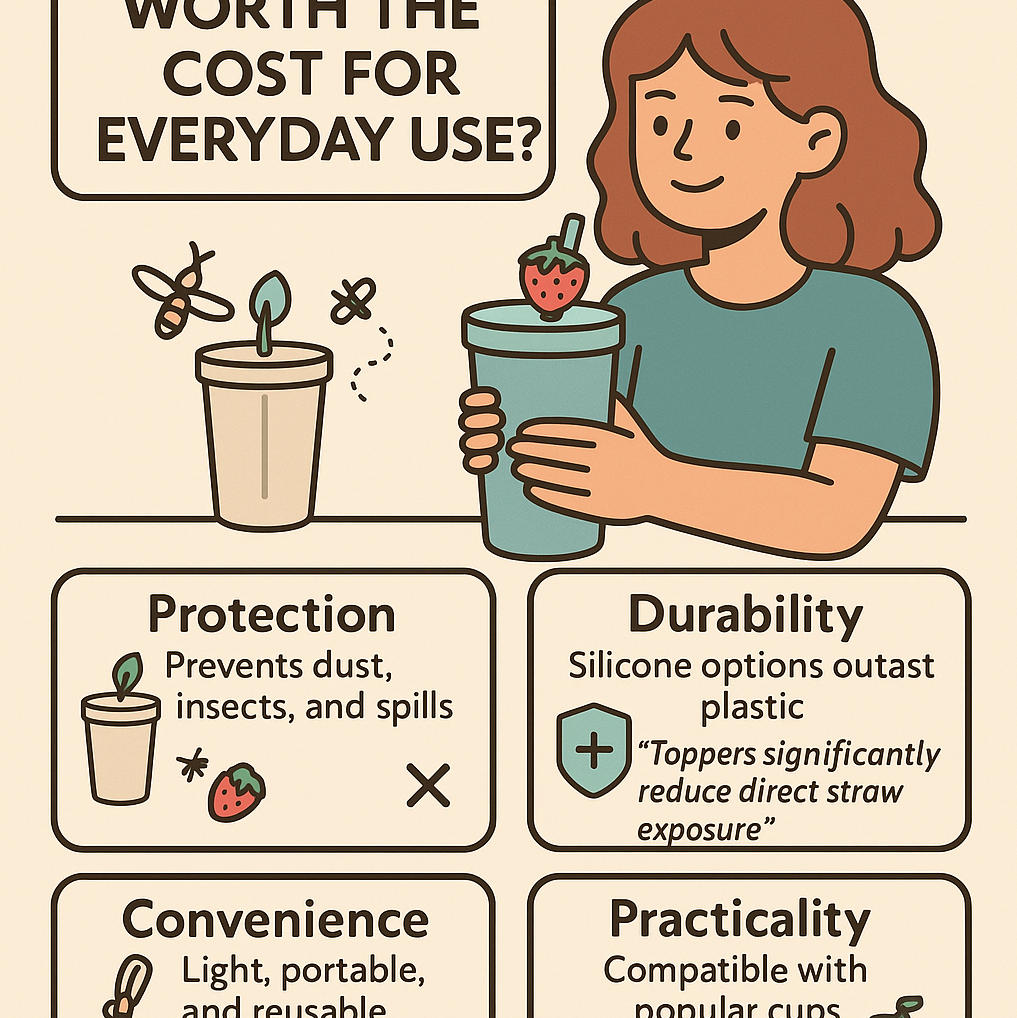
Why do people keep buying them? The answer lies in a blend of practicality and value.
Protection: Straw toppers prevent airborne dust, insects, and accidental spills—especially for outdoor drinkers and school lunchboxes.
Durability: Silicone options outlast plastic versions, staying intact even with daily use and dishwasher runs.
Hygiene: According to Dr. Lena Kim, a Sydney-based food safety expert, "Toppers significantly reduce direct straw exposure, cutting down the bacteria risk, especially in cafes or offices."
Convenience: Reusable toppers are light, portable, and clip onto straws without fuss, making them ideal for commutes, gyms, and cafes.
Practicality: Many are compatible with popular cups like Stanley and Owala, giving them cross-brand value.
From a cost perspective, most silicone straw toppers retail between $2–$8 each. Though this might seem unnecessary at first glance, their reusability offers genuine return on investment. Brands like Stanley and Gaily Bottle now include them as part of premium kits—a clear indicator of their rising status.
Products such as The Stay Smooth Straw Topper by Stanley have received recognition for design and safety, further enhancing buyer confidence. Many online reviews highlight how they save parents from replacing entire straws due to wear or contamination.
“If you have ever found a bug floating in your drink or had to bin a straw because of sticky fingers, then yes—these are worth every dollar,” Julia concludes with a laugh.
Conclusion
“They're a no-brainer for hygiene,” says Dr. Ellie Parsons, public health expert, “especially when you're on the go or sharing spaces.” And let's be honest — who hasn’t copped a bug in their iced latte?
If you love your tumbler and use it daily, grabbing a topper isn’t just smart — it’s savvy. Just make sure it fits, stays put, and doesn’t melt in the dishwasher.
Not always. Straw toppers come in different diameters and materials, so one size doesn't fit all. Most are designed to fit either 10mm or 12mm straws (common with Stanley and Owala). Always check sizing in product descriptions — especially if you're buying from Etsy or Amazon.
Most high-quality silicone toppers are made from food-grade, BPA-free silicone, which is flexible, reusable, and safe for everyday use. Make sure the product clearly states it's certified for food contact — especially if you're shopping from non-branded sites.
Here’s how to keep your straw toppers germ-free:
Rinse with hot water after every use
Use a soft brush or straw cleaner for the inside
Run them through the top rack of the dishwasher if dishwasher-safe
Let them fully air dry before storing
Straw toppers can reduce splashing or minor spills from tipping, but they aren't leak-proof like a sealed lid. Think of them more as a protective cap — helpful on bumpy car rides or around young kids.
Yes. Many brands now offer toppers made from biodegradable silicone or recyclable materials. Reusability also makes them a low-waste accessory — especially compared to disposable straw covers used in cafes.
Because they’re fun! But also — they serve a purpose:
Easy for kids to remember which drink is theirs
Great as themed party accessories
Often include a small grip to prevent sliding
Can spark joy in daily use — and that matters!
If you’re crafty, yes! You can use molds and food-safe silicone to create your own. There are even kits online. Just make sure you measure your straw diameter accurately before starting.
Absolutely. This is actually one of their most practical uses. Whether you're at a picnic or on a patio, straw toppers keep unwanted insects out of your drink — especially bees and flies.
Prices vary:
If you're buying in packs, they often come cheaper per piece. It's a small cost for a surprisingly helpful accessory.
Basic silicone toppers: $2–$4
Themed or branded designs: $5–$10
Custom or handmade toppers: $8–$15+

Leave a comment